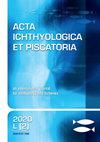爱琴海、黑海和马尔马拉海蓝鱼种群形态差异的评价
IF 1
4区 农林科学
Q3 FISHERIES
引用次数: 2
摘要
蓝鱼的种群结构,Pomatomus saltatrix(林奈,1766),在土耳其水域几乎没有在文献中描述。为了确定任何不同的蓝鱼种群单位,并重申先前研究的结果,选择了四个区域:爱琴海、黑海西部、黑海东部和马尔马拉海。本研究将桁架网络形态计量学、力学分析和耳石形状分析成功地应用于蓝鱼不同种群的鉴定。多变量方差分析(MANOVA)显示,雄性和雌性在桁架网络形态计量学、分生和耳石形状特征方面没有差异。因此,将两性结合起来进行判别函数(DFA)和主成分分析(PCA)。基于逐步方法的单变量方差分析显示,不同位置的各桁架形态特征和耳石形状特征差异极显著。此外,7个分生性状中有6个在不同区域间也表现出显著差异。基于主成分分析,27个桁架形态计量性状中有25个荷载值在0.70以上,在本研究中为0。DFA分析结果显示,蓝鱼种群的结构形态特征变化明显,形成了4个不同的集群,彼此之间有很好的分离,表明蓝鱼存在4个形态分化的种群。正确分类的爱琴海、黑海西部和黑海东部蓝鱼样本与原始种群的比例为100%,表明这些种群之间存在明显的分离。然而,多达5%的马尔马拉海样本被错误地归类为黑海东部。这些发现得到了分生和耳石形状特征的支持,这些特征也表明了蓝鱼的四个形态分化种群。但是,它们的分类正确率相对低于桁架形态计量性状法。研究结果表明,有必要对每种蓝鱼种群进行单独的战略评估和管理,以便在未来可持续地利用它们。本文章由计算机程序翻译,如有差异,请以英文原文为准。
Assessment of morphological variation between stocks of bluefish, Pomatomus saltatrix (Actinopterygii, Perciformes, Pomatomidae), in the Aegean Sea, Black Sea, and Sea of Marmara
The population structure of the bluefish, Pomatomus saltatrix (Linnaeus, 1766), in Turkish waters is scarcely described in the literature. To identify any distinct population units of bluefish, and reaffirm the findings of a previous study, four areas were selected: the Aegean Sea, western Black Sea, eastern Black Sea, and the Sea of Marmara. In this study, truss network morphometrics, meristics, and otolith shape analyses were successfully applied for different population identification of the bluefish. Multivariate analysis of variance (MANOVA) revealed no differences for truss network morphometrics, meristic, and otolith shape characters between males and females. Hence, both sexes were combined for the discriminant function (DFA) and the Principal Component Analysis (PCA). Using univariate ANOVA based on the stepwise method revealed a highly significant difference among different locations for each truss-morphometrics and otolith shape characters. Furthermore, six out of seven meristic characters also showed significant differences between different areas. Based on PCA, 25 out of 27 truss-morphometric characters had a loading value above 0.70, which was considered significant in this study. The results of DFA show clear patterns of truss-morphometric character variations, forming four distinct clusters that were well separated from each other, indicating the existence of four morphologically differentiated populations of the bluefish. The proportion of the correctly classified Aegean Sea, western Black Sea, and eastern Black Sea bluefish samples to their original groups were 100%, demonstrating clear separation of these stocks from each other. Whereas up to 5% of the total samples of the Sea of Marmara were incorrectly classified, assigning to the eastern Black Sea. These findings were supported by meristic and otolith shape characters that also indicated four morphologically differentiated populations of the bluefish. However, their overall proportion of correct classification was relatively lower than the truss-morphometric traits method. The findings suggest the requirement of strategic assessment and management of each bluefish stock separately to use them sustainably in the future.
求助全文
通过发布文献求助,成功后即可免费获取论文全文。
去求助
来源期刊

Acta Ichthyologica Et Piscatoria
FISHERIES-ZOOLOGY
CiteScore
2.20
自引率
0.00%
发文量
31
审稿时长
>12 weeks
期刊介绍:
ACTA ICHTHYOLOGICA ET PISCATORIA (AIeP) is an international, peer-reviewed scientific journal that publishes articles based on original experimental data or experimental methods, or new analyses of already existing data, in any aspect of ichthyology and fisheries (fin-fish only).
 求助内容:
求助内容: 应助结果提醒方式:
应助结果提醒方式:


